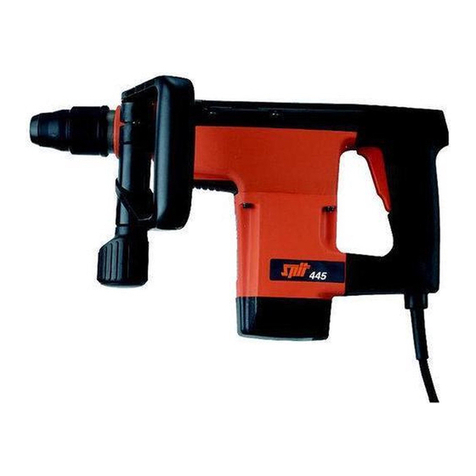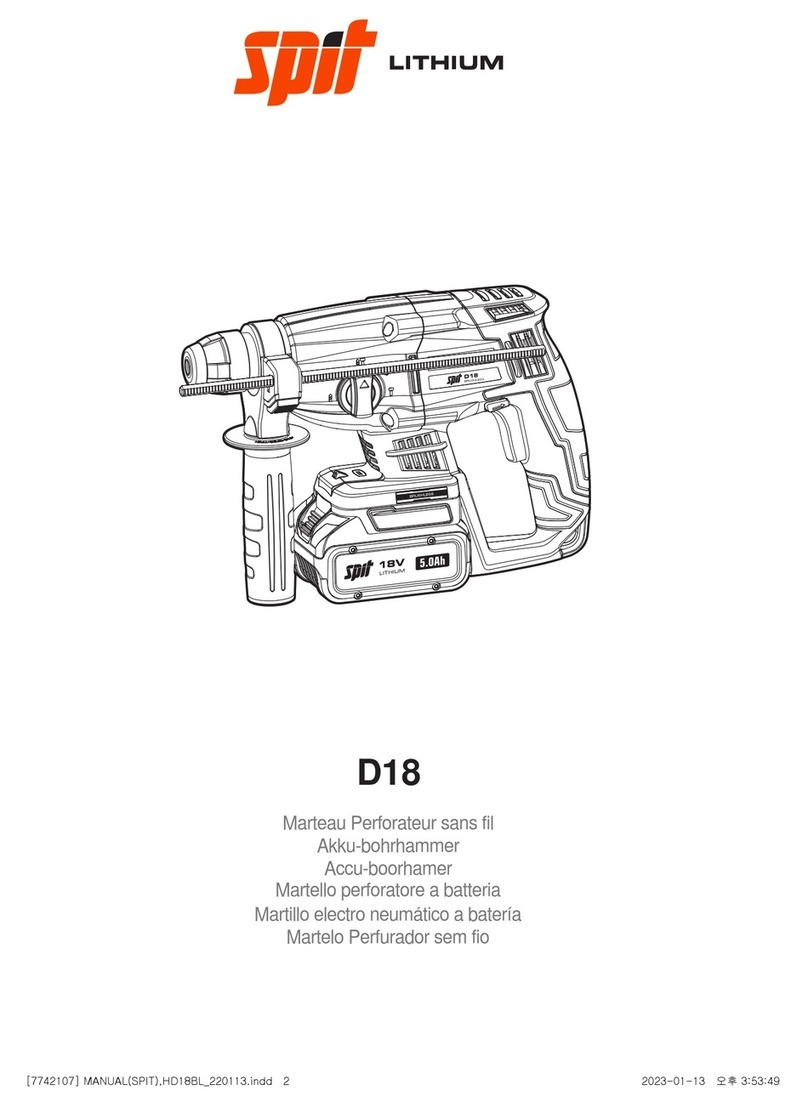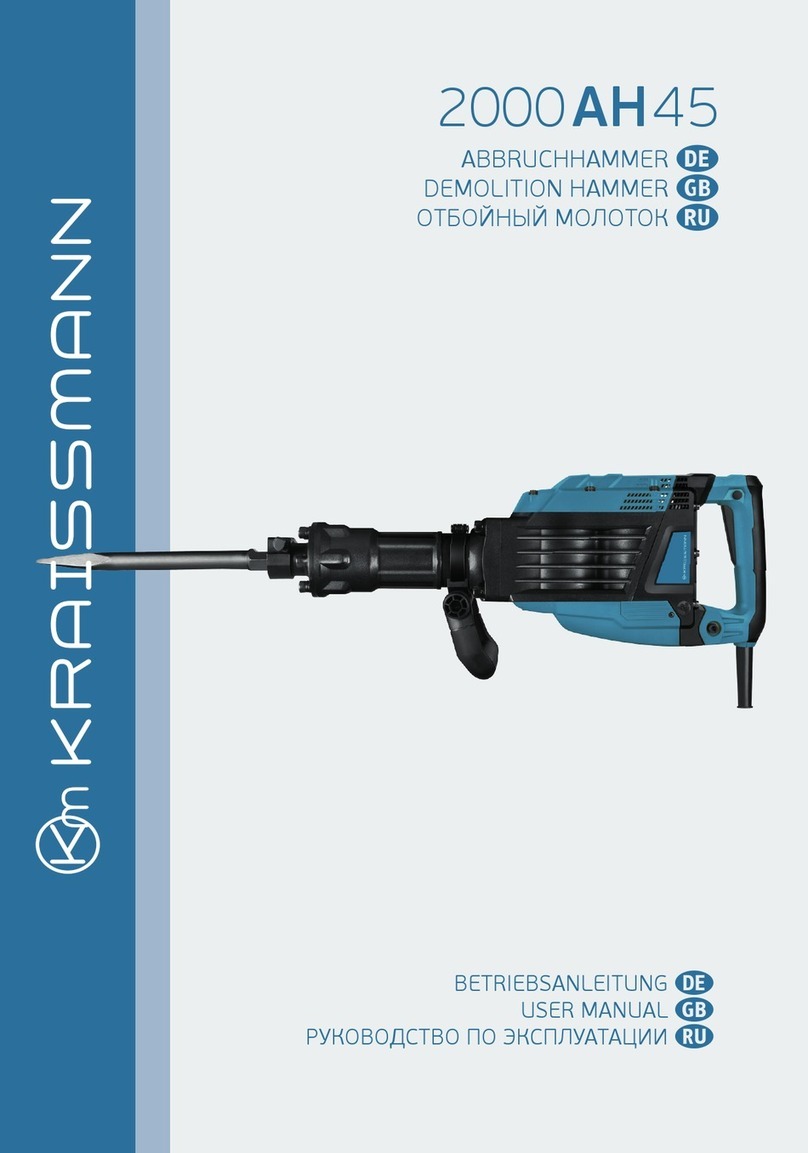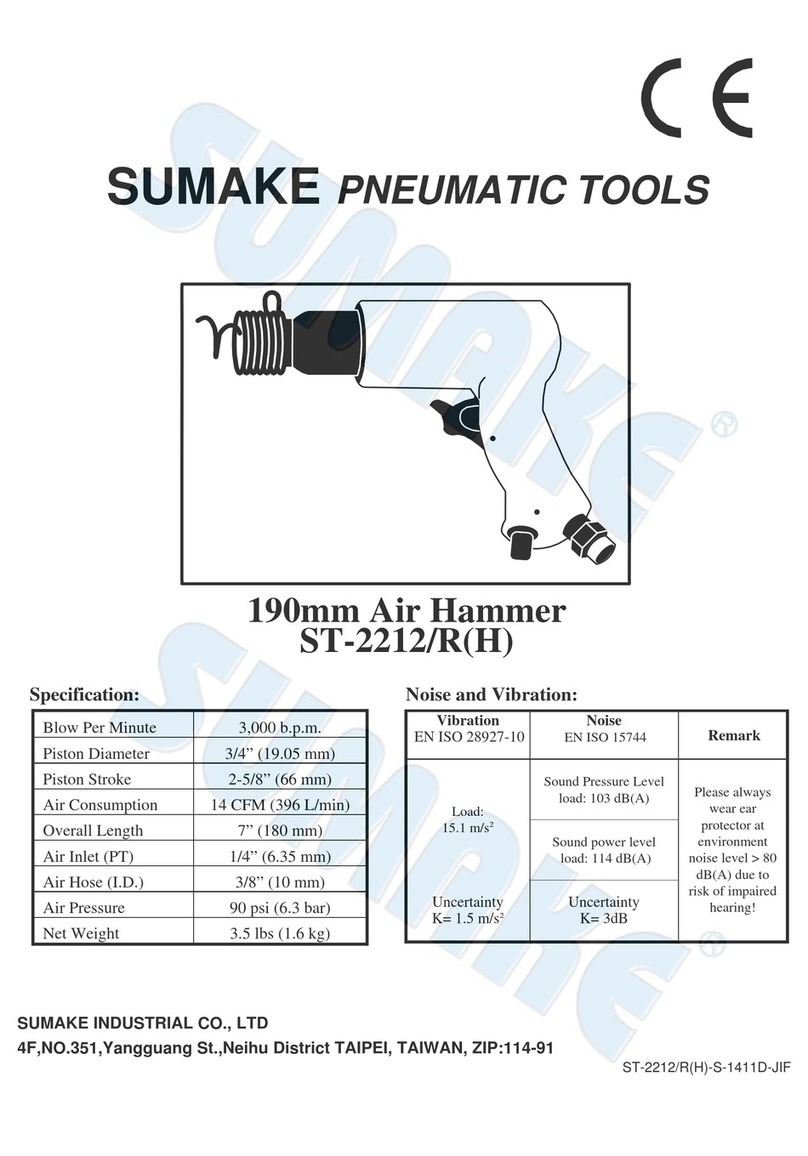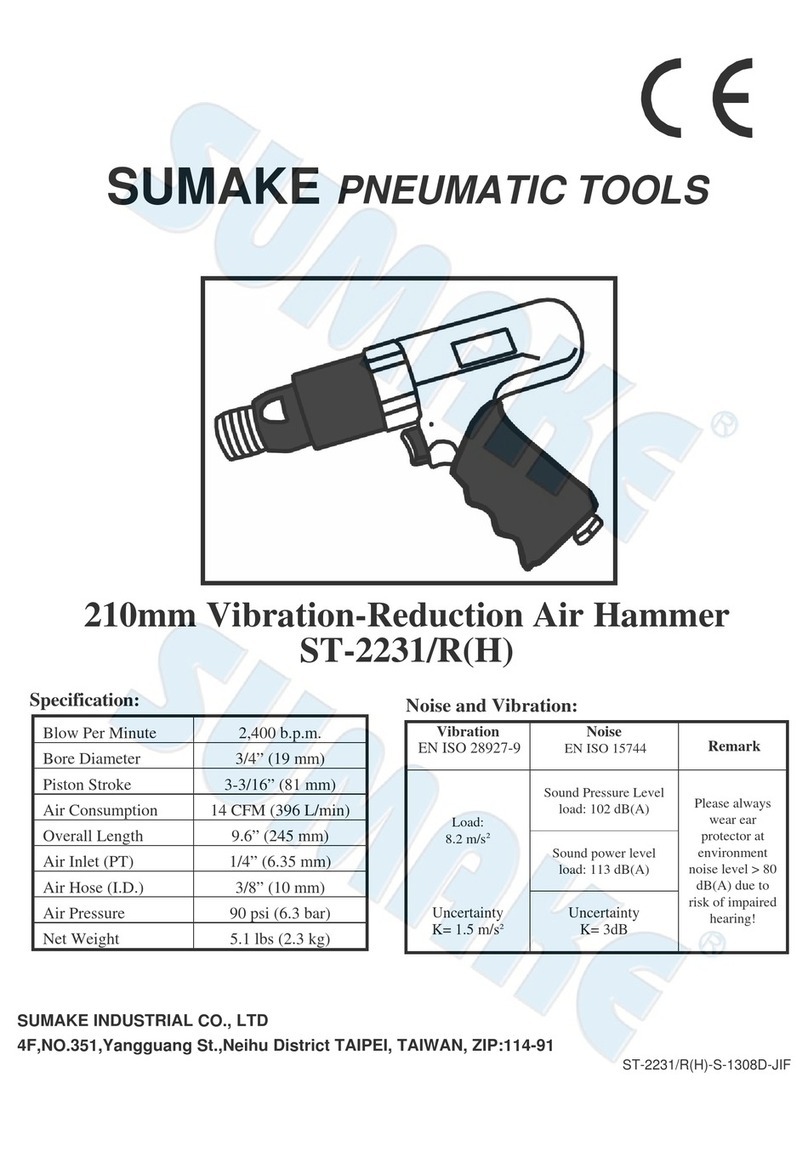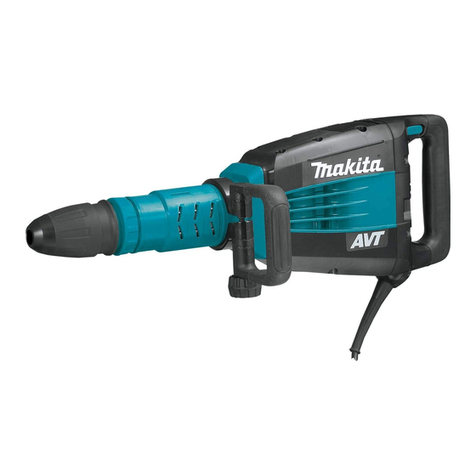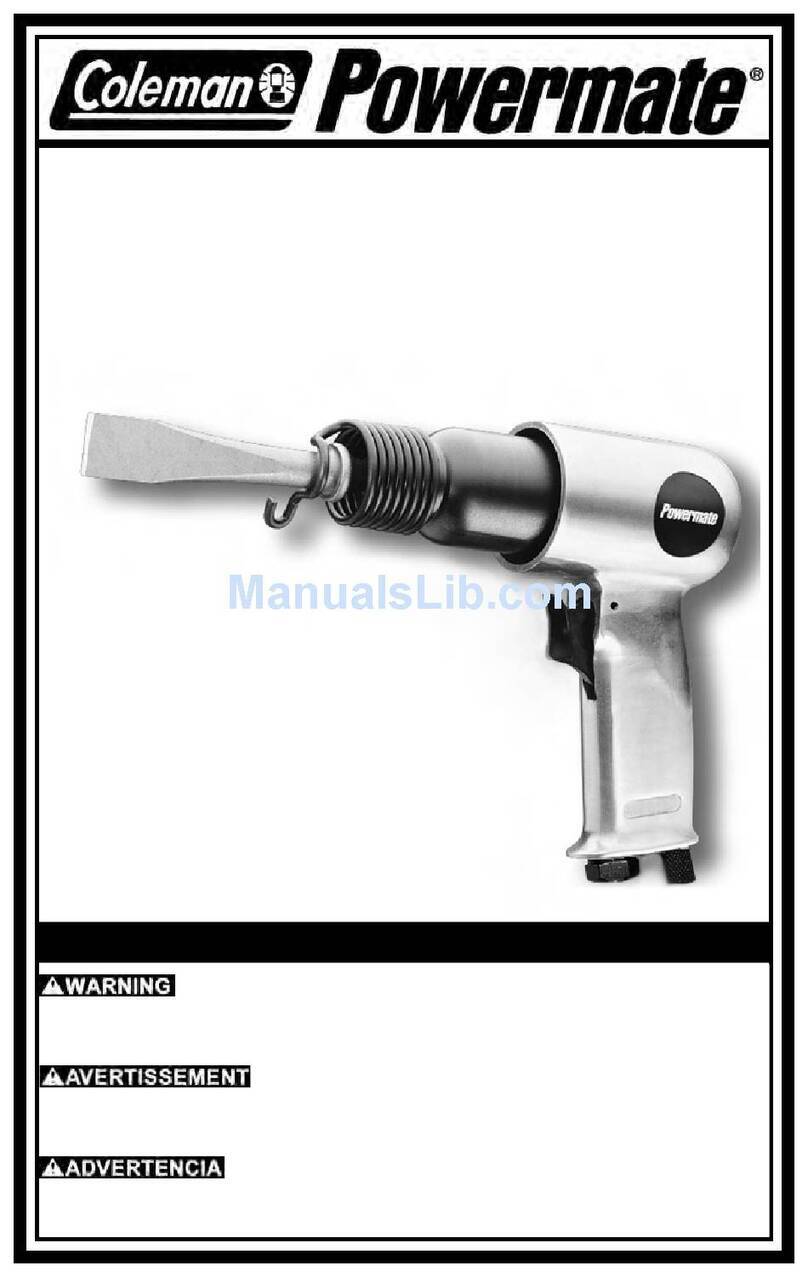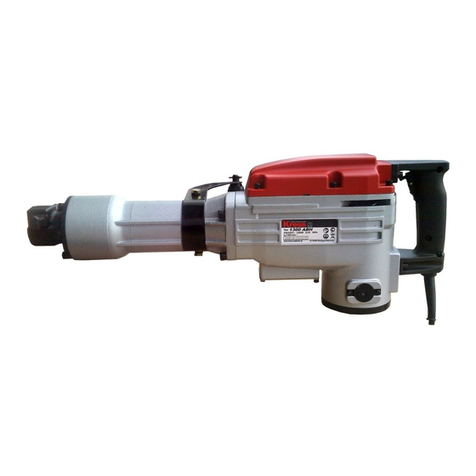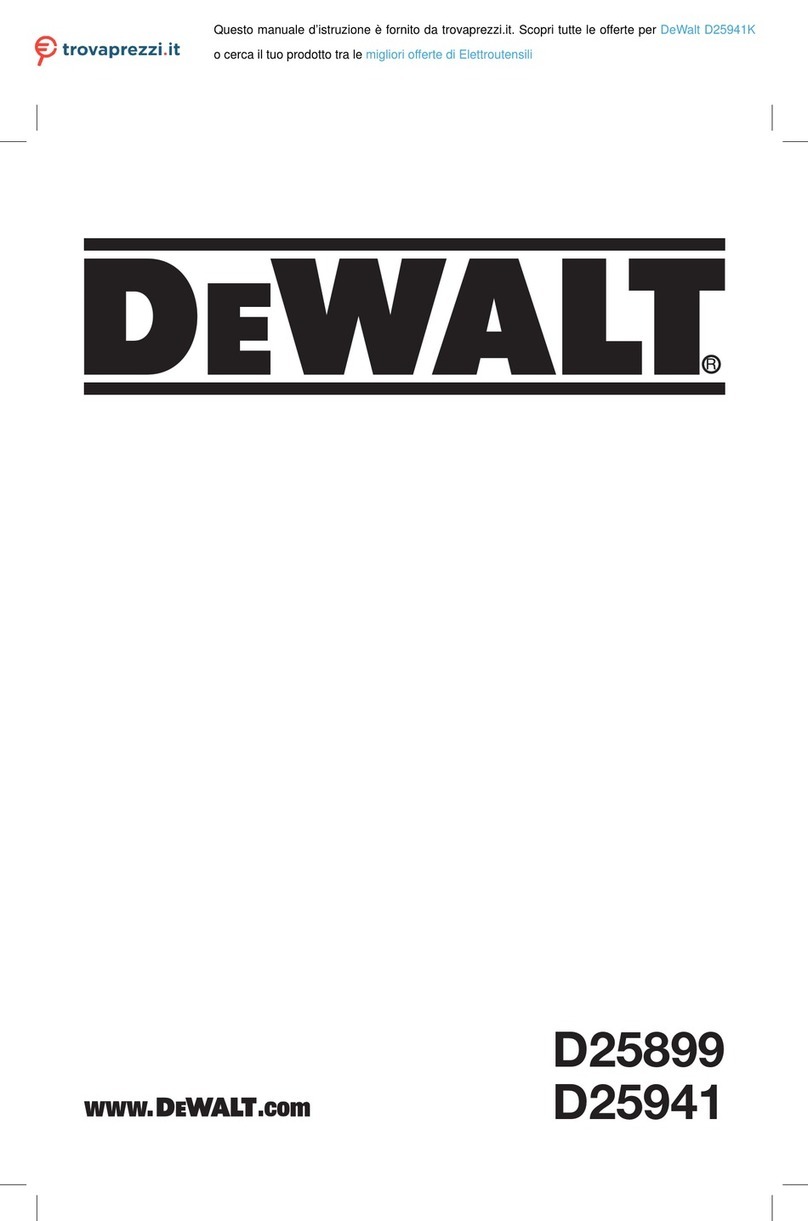SPIT 493 User manual

de Originalbetriebsanleitung . . . . . . . . . . . . . . . . . . . . . . . . . . . . . . . Seite 2
en Original instructions. . . . . . . . . . . . . . . . . . . . . . . . . . . . . . . . . . . . . Page 8
fr Notice originale. . . . . . . . . . . . . . . . . . . . . . . . . . . . . . . . Page 13
es Manual original . . . . . . . . . . . . . . . . . . . . . . . . . . . . . . Página 19
pt Manual original . . . . . . . . . . . . . . . . . . . . . . . . . . . . . . Página 25
it Istruzioni originali . . . . . . . . . . . . . . . . . . . . . . . . . . . . Pagina 31
nl Oorspronkelijke gebruiksaanwijzing . . . . . . . . . . . . . . Pagina 37
da Original brugsanvisning . . . . . . . . . . . . . . . . . . . . . . . . . Side 43
fi Alkuperäiset ohjeet . . . . . . . . . . . . . . . . . . . . . . . . . . . . . Sivu 48
el Πρωτότυπο οδηγιών χρήσης . . . . . . . . . . . . . . . . . . . . Σελίδα 53
pl Instrukcja oryginalna. . . . . . . . . . . . . . . . . . . . . . . . . . Strona 59
cs Původní návod k používání . . . . . . . . . . . . . . . . . . . . . . Strana 65
ar . . . . . . . . . . . . . . . . . . . . . . . . . . 74
ςТЎϩХʉ ЌТϾϦφЍʉ ʌμВТЎϺυ
OBJ_BUCH-1987-002.book Page 1 Wednesday, August 5, 2015 1:23 PM

Deutsch | 2
1 609 92A 1HH • 5.8.15
Deutsch
Allgemeine Sicherheitshinweise
für Elektrowerkzeuge
Lesen Sie alle Sicherheitshinweise
und Anweisungen. Versäumnisse
bei der Einhaltung der Sicherheitshinweise und An-
weisungen können elektrischen Schlag, Brand
und/oder schwere Verletzungen verursachen.
Bewahren Sie alle Sicherheitshinweise und Anwei-
sungen für die Zukunft auf.
Der in den Sicherheitshinweisen verwendete Begriff
„Elektrowerkzeug“ bezieht sich auf netzbetriebene
Elektrowerkzeuge (mit Netzkabel) und auf akkubetrie-
bene Elektrowerkzeuge (ohne Netzkabel).
Arbeitsplatzsicherheit
Halten Sie Ihren Arbeitsbereich sauber und gut
beleuchtet. Unordnung oder unbeleuchtete Ar-
beitsbereiche können zu Unfällen führen.
Arbeiten Sie mit dem Elektrowerkzeug nicht in
explosionsgefährdeter Umgebung, in der sich
brennbare Flüssigkeiten, Gase oder Stäube be-
finden. Elektrowerkzeuge erzeugen Funken, die
den Staub oder die Dämpfe entzünden können.
Halten Sie Kinder und andere Personen wäh-
rend der Benutzung des Elektrowerkzeugs fern.
Bei Ablenkung können Sie die Kontrolle über das
Gerät verlieren.
Elektrische Sicherheit
Der Anschlussstecker des Elektrowerkzeuges
muss in die Steckdose passen. Der Stecker darf
in keiner Weise verändert werden. Verwenden
Sie keine Adapterstecker gemeinsam mit
schutzgeerdeten Elektrowerkzeugen. Unverän-
derte Stecker und passende Steckdosen verrin-
gern das Risiko eines elektrischen Schlages.
Vermeiden Sie Körperkontakt mit geerdeten
Oberflächen wie von Rohren, Heizungen, Her-
den und Kühlschränken. Es besteht ein erhöhtes
Risiko durch elektrischen Schlag, wenn Ihr Körper
geerdet ist.
Halten Sie Elektrowerkzeuge von Regen oder
Nässe fern. Das Eindringen von Wasser in ein
Elektrowerkzeug erhöht das Risiko eines elektri-
schen Schlages.
Zweckentfremden Sie das Kabel nicht, um das
Elektrowerkzeug zu tragen, aufzuhängen oder
um den Stecker aus der Steckdose zu ziehen.
Halten Sie das Kabel fern von Hitze, Öl, scharfen
Kanten oder sich bewegenden Geräteteilen. Be-
schädigte oder verwickelte Kabel erhöhen das Ri-
siko eines elektrischen Schlages.
Wenn Sie mit einem Elektrowerkzeug im Freien
arbeiten, verwenden Sie nur Verlängerungska-
bel, die auch für den Außenbereich geeignet
sind. Die Anwendung eines für den Außenbereich
geeigneten Verlängerungskabels verringert das Ri-
siko eines elektrischen Schlages.
Wenn der Betrieb des Elektrowerkzeuges in
feuchter Umgebung nicht vermeidbar ist, ver-
wenden Sie einen Fehlerstromschutzschalter.
Der Einsatz eines Fehlerstromschutzschalters ver-
mindert das Risiko eines elektrischen Schlages.
Sicherheit von Personen
Seien Sie aufmerksam, achten Sie darauf, was
Sie tun, und gehen Sie mit Vernunft an die Arbeit
mit einem Elektrowerkzeug. Benutzen Sie kein
Elektrowerkzeug, wenn Sie müde sind oder un-
ter dem Einfluss von Drogen, Alkohol oder Medi-
kamenten stehen. Ein Moment der Unachtsam-
keit beim Gebrauch des Elektrowerkzeuges kann
zu ernsthaften Verletzungen führen.
Tragen Sie persönliche Schutzausrüstung und
immer eine Schutzbrille. Das Tragen persönlicher
Schutzausrüstung, wie Staubmaske, rutschfeste
Sicherheitsschuhe, Schutzhelm oder Gehör-
schutz, je nach Art und Einsatz des Elektrowerk-
zeuges, verringert das Risiko von Verletzungen.
Vermeiden Sie eine unbeabsichtigte Inbetrieb-
nahme. Vergewissern Sie sich, dass das Elektro-
werkzeug ausgeschaltet ist, bevor Sie es an die
Stromversorgung und/oder den Akku anschlie-
ßen, es aufnehmen oder tragen. Wenn Sie beim
Tragen des Elektrowerkzeuges den Finger am
Schalter haben oder das Gerät eingeschaltet an
die Stromversorgung anschließen, kann dies zu
Unfällen führen.
Entfernen Sie Einstellwerkzeuge oder Schrau-
benschlüssel, bevor Sie das Elektrowerkzeug
einschalten. Ein Werkzeug oder Schlüssel, der
sich in einem drehenden Geräteteil befindet, kann
zu Verletzungen führen.
Vermeiden Sie eine abnormale Körperhaltung.
Sorgen Sie für einen sicheren Stand und halten
Sie jederzeit das Gleichgewicht. Dadurch kön-
nen Sie das Elektrowerkzeug in unerwarteten Situ-
ationen besser kontrollieren.
Tragen Sie geeignete Kleidung. Tragen Sie kei-
ne weite Kleidung oder Schmuck. Halten Sie
Haare, Kleidung und Handschuhe fern von sich
WARNUNG
OBJ_BUCH-1987-002.book Page 2 Wednesday, August 5, 2015 1:23 PM

Deutsch | 3
1 609 92A 1HH • 5.8.15
bewegenden Teilen. Lockere Kleidung, Schmuck
oder lange Haare können von sich bewegenden
Teilen erfasst werden.
Wenn Staubabsaug- und -auffangeinrichtungen
montiert werden können, vergewissern Sie sich,
dass diese angeschlossen sind und richtig ver-
wendet werden. Verwendung einer Staubabsau-
gung kann Gefährdungen durch Staub verringern.
Verwendung und Behandlung des
Elektrowerkzeuges
Überlasten Sie das Gerät nicht. Verwenden Sie
für Ihre Arbeit das dafür bestimmte Elektrowerk-
zeug. Mit dem passenden Elektrowerkzeug arbei-
ten Sie besser und sicherer im angegebenen Leis-
tungsbereich.
Benutzen Sie kein Elektrowerkzeug, dessen
Schalter defekt ist. Ein Elektrowerkzeug, das sich
nicht mehr ein- oder ausschalten lässt, ist gefähr-
lich und muss repariert werden.
Ziehen Sie den Stecker aus der Steckdose
und/oder entfernen Sie den Akku, bevor Sie Ge-
räteeinstellungen vornehmen, Zubehörteile
wechseln oder das Gerät weglegen. Diese Vor-
sichtsmaßnahme verhindert den unbeabsichtigten
Start des Elektrowerkzeuges.
Bewahren Sie unbenutzte Elektrowerkzeuge au-
ßerhalb der Reichweite von Kindern auf. Lassen
Sie Personen das Gerät nicht benutzen, die mit
diesem nicht vertraut sind oder diese Anweisun-
gen nicht gelesen haben. Elektrowerkzeuge sind
gefährlich, wenn sie von unerfahrenen Personen
benutzt werden.
Pflegen Sie Elektrowerkzeuge mit Sorgfalt. Kon-
trollieren Sie, ob bewegliche Teile einwandfrei
funktionieren und nicht klemmen, ob Teile ge-
brochen oder so beschädigt sind, dass die Funk-
tion des Elektrowerkzeuges beeinträchtigt ist.
Lassen Sie beschädigte Teile vor dem Einsatz
des Gerätes reparieren. Viele Unfälle haben ihre
Ursache in schlecht gewarteten Elektrowerkzeu-
gen.
Halten Sie Schneidwerkzeuge scharf und sau-
ber. Sorgfältig gepflegte Schneidwerkzeuge mit
scharfen Schneidkanten verklemmen sich weniger
und sind leichter zu führen.
Verwenden Sie Elektrowerkzeug, Zubehör, Ein-
satzwerkzeuge usw. entsprechend diesen An-
weisungen. Berücksichtigen Sie dabei die Ar-
beitsbedingungen und die auszuführende
Tätigkeit. Der Gebrauch von Elektrowerkzeugen
für andere als die vorgesehenen Anwendungen
kann zu gefährlichen Situationen führen.
Service
Lassen Sie Ihr Elektrowerkzeug nur von qualifi-
ziertem Fachpersonal und nur mit Original-Er-
satzteilen reparieren. Damit wird sichergestellt,
dass die Sicherheit des Elektrowerkzeuges erhal-
ten bleibt.
Sicherheitshinweise für Hämmer
Tragen Sie Gehörschutz. Die Einwirkung von Lärm
kann Gehörverlust bewirken.
Benutzen Sie Zusatzgriffe, wenn diese mit dem
Elektrowerkzeug mitgeliefert werden. Der Verlust
der Kontrolle kann zu Verletzungen führen.
Halten Sie das Gerät an den isolierten Griffflä-
chen, wenn Sie Arbeiten ausführen, bei denen
das Einsatzwerkzeug verborgene Stromleitun-
gen oder das eigene Netzkabel treffen kann. Der
Kontakt mit einer spannungsführenden Leitung
kann auch metallene Geräteteile unter Spannung
setzen und zu einem elektrischen Schlag führen.
Weitere Sicherheits- und
Arbeitshinweise
Beachten Sie die Netzspannung! Die Spannung
der Stromquelle muss mit den Angaben auf dem
Typenschild des Elektrowerkzeuges überein-
stimmen.
Verwenden Sie geeignete Suchgeräte, um ver-
borgene Versorgungsleitungen aufzuspüren,
oder ziehen Sie die örtliche Versorgungsgesell-
schaft hinzu. Kontakt mit Elektroleitungen kann zu
Feuer und elektrischem Schlag führen. Beschädi-
gung einer Gasleitung kann zur Explosion führen.
Eindringen in eine Wasserleitung verursacht Sach-
beschädigung oder kann einen elektrischen Schlag
verursachen.
Ziehen Sie den Zusatzhandgriff fest an, halten
Sie das Elektrowerkzeug beim Arbeiten fest mit
beiden Händen und sorgen Sie für einen sicheren
Stand. Das Elektrowerkzeug wird mit zwei Händen
sicher geführt.
SDS-max-Einsatzwerkzeug einsetzen: Überprü-
fen Sie die Verriegelung durch Ziehen am Werk-
zeug.
Lassen Sie eine beschädigte Staubschutzkappe
sofort ersetzen. Die Staubschutzkappe verhindert
weitgehend das Eindringen von Bohrstaub in die
Werkzeugaufnahme während des Betriebes. Ach-
ten Sie beim Einsetzen des Werkzeuges darauf,
dass die Staubschutzkappe nicht beschädigt wird.
OBJ_BUCH-1987-002.book Page 3 Wednesday, August 5, 2015 1:23 PM

Deutsch | 4
1 609 92A 1HH • 5.8.15
Stäube von Materialien wie bleihaltigem An-
strich, einigen Holzarten, Mineralien und Metall
können gesundheitsschädlich sein und zu aller-
gischen Reaktionen, Atemwegserkrankungen
und/oder Krebs führen. Asbesthaltiges Material
darf nur von Fachleuten bearbeitet werden.
–Sorgen Sie für gute Belüftung des Arbeitsplat-
zes.
–Es wird empfohlen, eine Atemschutzmaske mit
Filterklasse P2 zu tragen.
Beachten Sie in Ihrem Land gültige Vorschriften für
die zu bearbeitenden Materialien.
Um Energie zu sparen, schalten Sie das Elektro-
werkzeug nur ein, wenn Sie es benutzen.
Halten Sie das Elektrowerkzeug beim Arbeiten
fest mit beiden Händen und sorgen Sie für einen
sicheren Stand. Das Elektrowerkzeug wird mit zwei
Händen sicherer geführt.
Sichern Sie das Werkstück. Ein mit Spannvorrich-
tungen oder Schraubstock festgehaltenes Werk-
stück ist sicherer gehalten als mit Ihrer Hand.
Warten Sie, bis das Elektrowerkzeug zum Still-
stand gekommen ist, bevor Sie es ablegen. Das
Einsatzwerkzeug kann sich verhaken und zum Ver-
lust der Kontrolle über das Elektrowerkzeug führen.
Symbole
Die nachfolgenden Symbole sind für das Lesen und
Verstehen der Betriebsanleitung von Bedeutung. Prä-
gen Sie sich die Symbole und ihre Bedeutung ein. Die
richtige Interpretation der Symbole hilft Ihnen, das
Elektrowerkzeug besser und sicherer zu gebrauchen.
Symbol Bedeutung
Spit 493: Schlaghammer
grau markierter Bereich: Handgriff
(isolierte Grifffläche)
Sachnummer
Lesen Sie alle Sicherheitshinweise
und Anweisungen
Ziehen Sie vor allen Arbeiten am
Elektrowerkzeug den Netzstecker
aus der Steckdose
Tragen Sie Schutzhandschuhe
XXXXXX
Tragen Sie Gehörschutz.
Tragen Sie eine Schutzbrille
Bewegungsrichtung
Reaktionsrichtung
Nächster Handlungsschritt
Meißeln
Kleine Schlagzahl
Große Schlagzahl
Einschalten
Ausschalten
Meißelstellung verändern
Werkzeugaufnahme
Fetten Sie das Einsteckende des
Einsatzwerkzeugs leicht ein
Service-Anzeige
P1Nennaufnahmeleistung
nSSchlagzahl
E Einzelschlagstärke entsprechend
EPTA-Procedure 05/2009
Gewicht entsprechend
EPTA-Procedure 01:2014
Schutzklasse
LwA Schallleistungspegel
Symbol Bedeutung
OBJ_BUCH-1987-002.book Page 4 Wednesday, August 5, 2015 1:23 PM

Deutsch | 5
1 609 92A 1HH • 5.8.15
Lieferumfang
Schlaghammer, Zusatzhandgriff.
Einsatzwerkzeug und weiteres abgebildetes oder be-
schriebenes Zubehör gehören nicht zum Standard-
Lieferumfang.
Das vollständige Zubehör finden Sie in unserem Zube-
hörprogramm.
Bestimmungsgemäßer Gebrauch
Das Elektrowerkzeug ist bestimmt für Meißelarbeiten
in Beton, Ziegel, Gestein und Asphalt sowie mit ent-
sprechendem Zubehör auch zum Eintreiben und Ver-
dichten.
Technische Daten
Die Technischen Daten des Produkts sind in der Ta-
belle auf Seite 75 angegeben.
Die Angaben gelten für eine Nennspannung [U] von
230 V. Bei abweichenden Spannungen und in länder-
spezifischen Ausführungen können diese Angaben
variieren.
Konformitätserklärung
Wir erklären in alleiniger Verantwortung, dass das un-
ter „Technische Daten“ beschriebene Produkt allen
einschlägigen Bestimmungen der Richtlinien
2011/65/EU, bis 19. April 2016: 2004/108/EG, ab
20. April 2016: 2014/30/EU, 2006/42/EG,
2000/14/EG einschließlich ihrer Änderungen ent-
spricht und mit folgenden Normen übereinstimmt:
EN 60745-1, EN 60745-2-6.
2000/14/EG: Garantierter Schallleistungspegel
105 dB(A). Bewertungsverfahren der Konformität ge-
mäß Anhang VI.
Produktkategorie: 10
Benannte Stelle:
TÜV NORD CERT GmbH & Co. KG,
Am TÜV 1, 30519 Hannover
Technische Unterlagen (2006/42/EG, 2000/14/EG)
bei:
SPIT SAS
150, Route de Lyon
26500 Bourg-lès-Valence Cedex
FRANCE
Jean-Michel DREVETON
SPIT Quality Manager
Operations Valence
SPIT SAS; 150, Route de Lyon;
26500 Bourg-lès-Valence Cedex
FRANCE
05.08.2015
Geräusch-/Vibrationsinformation
Die Messwerte des Produkts sind in der Tabelle auf
Seite 75 angegeben.
Geräuschemissionswerte ermittelt entsprechend
EN 60745-2-6.
Schwingungsgesamtwerte ah(Vektorsumme dreier
Richtungen) und Unsicherheit K ermittelt entspre-
chend EN 60745-2-6.
Der in diesen Anweisungen angegebene Schwin-
gungspegel ist entsprechend einem in EN 60745 ge-
normten Messverfahren gemessen worden und kann
für den Vergleich von Elektrowerkzeugen miteinander
verwendet werden. Er eignet sich auch für eine vorläu-
fige Einschätzung der Schwingungsbelastung.
Der angegebene Schwingungspegel repräsentiert die
hauptsächlichen Anwendungen des Elektrowerk-
zeugs. Wenn allerdings das Elektrowerkzeug für ande-
re Anwendungen, mit unterschiedlichen Zubehören,
mit abweichenden Einsatzwerkzeugen oder ungenü-
gender Wartung eingesetzt wird, kann der Schwin-
gungspegel abweichen. Dies kann die Schwingungs-
belastung über den gesamten Arbeitszeitraum
deutlich erhöhen.
Für eine genaue Abschätzung der Schwingungsbelas-
tung sollten auch die Zeiten berücksichtigt werden, in
denen das Gerät abgeschaltet ist oder zwar läuft, aber
nicht tatsächlich im Einsatz ist. Dies kann die Schwin-
gungsbelastung über den gesamten Arbeitszeitraum
deutlich reduzieren.
Legen Sie zusätzliche Sicherheitsmaßnahmen zum
Schutz des Bedieners vor der Wirkung von Schwin-
gungen fest wie zum Beispiel: Wartung von Elektro-
werkzeug und Einsatzwerkzeugen, Warmhalten der
Hände, Organisation der Arbeitsabläufe.
LpA Schalldruckpegel
KUnsicherheit
ahSchwingungsgesamtwert
Symbol Bedeutung
OBJ_BUCH-1987-002.book Page 5 Wednesday, August 5, 2015 1:23 PM
Table of contents
Languages:
Other SPIT Power Hammer manuals
Popular Power Hammer manuals by other brands

Hitachi
Hitachi H 65SC Instruction manual and safety instructions

Hitachi
Hitachi H 65SB2 Handling instructions
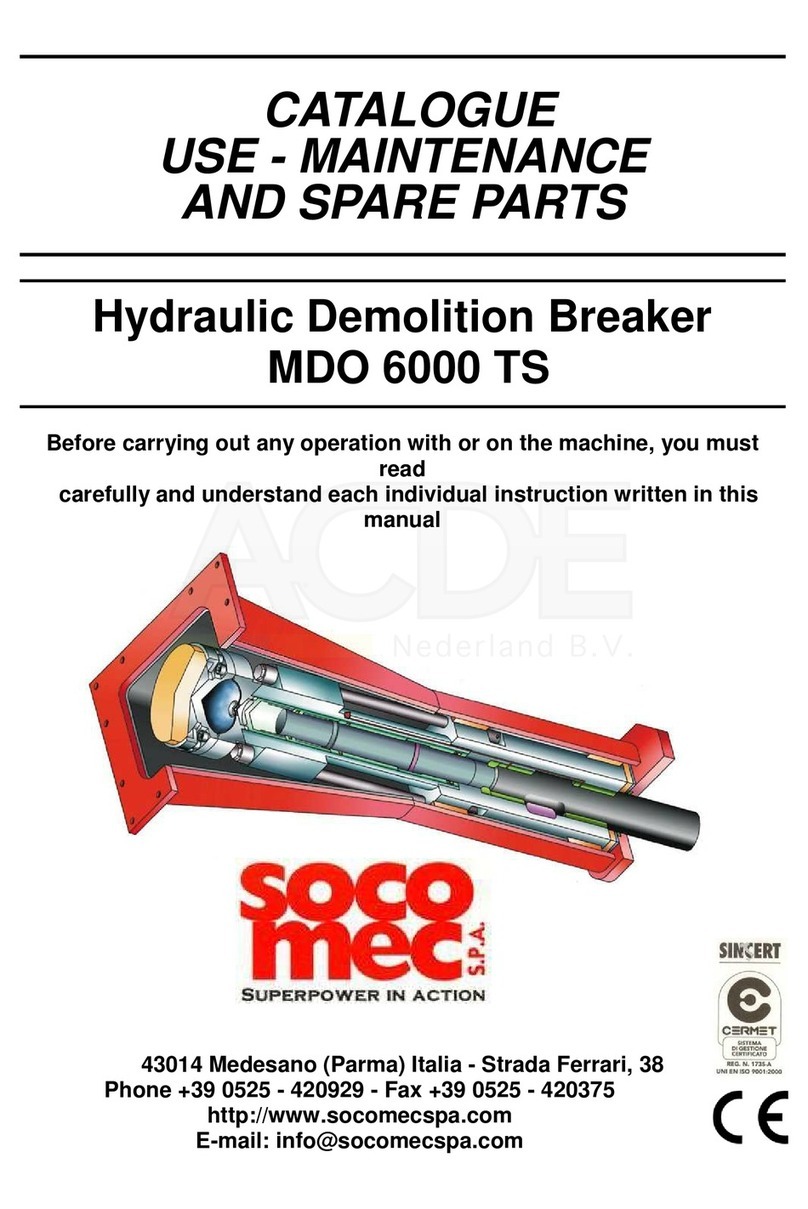
socomec
socomec MDO 6000 TS Use & maintenance
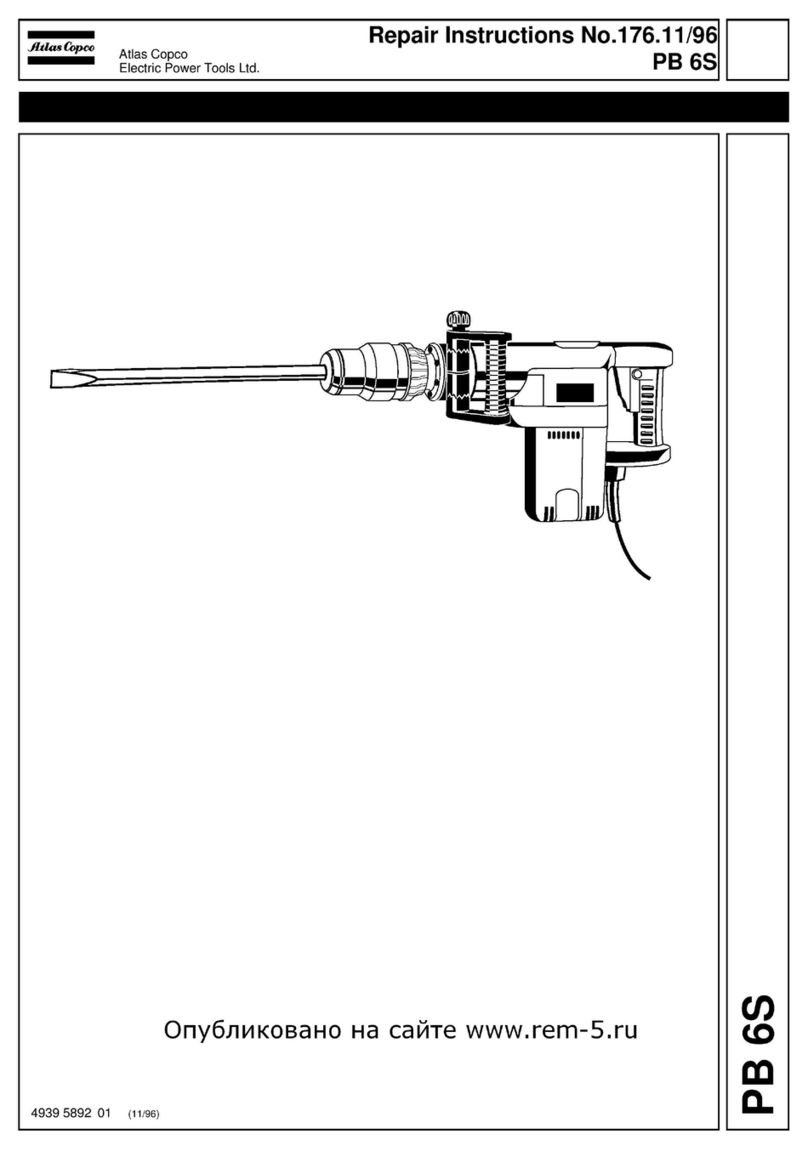
Atlas Copco
Atlas Copco PB 6S Repair instructions
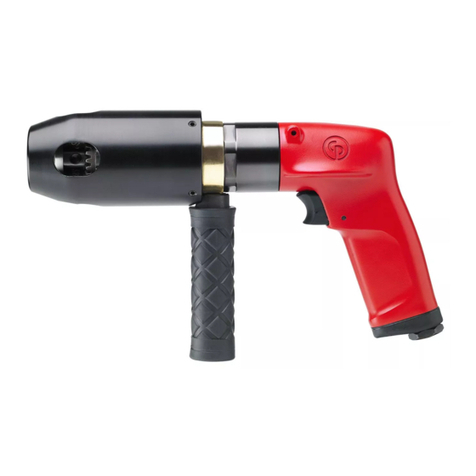
RODCRAFT
RODCRAFT RC5030 Operation manual
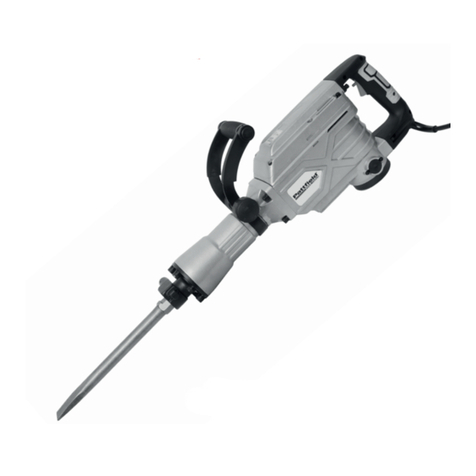
Pattfield Ergo Tools
Pattfield Ergo Tools PA-1700SH Translation of the original instructions
